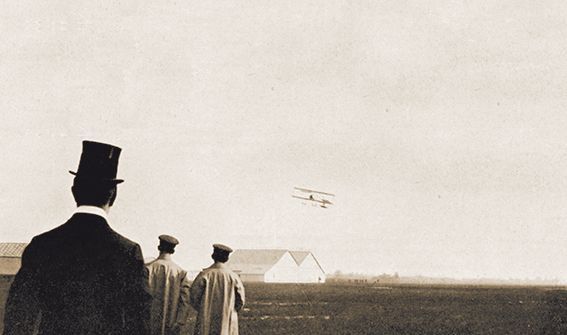
Princes Cyril and Boris of Bulgaria witnessed the flight of their father King Ferdinand in Sint-Job-in-'t-Goor. (coll. Dirk Buytaert)
The first Belgian aircraft manufacturers
You will undoubtedly wonder who repaired the damage sustained during the various accidents during the Antwerp flying week. This job was done by the workhouses of the Bollekens brothers in the Pelikaanstraat. Until then, they specialised in office furniture and “blaffeturen” (Antwerp for roller shutters).
Baron de Caters contacted them following his accident at the start of the flying week.
The brothers Eugène, Isidore and Jozef Bollekens, who knew the Caters, were asked to repair the baron's aircraft during the Antwerp flying week in 1909. It was not just a repair, but the making of new wings, tail and fuselage. The workmen were mobilised and after four days of working day and night, the baron was able to close the flight week with a flight. The brothers had seen that a number of improvements could be made. They were better equipped for woodworking than the original builders Farman and Aviatik. And so in Antwerp, in addition to the well-known Minerva car builder, we also got an aircraft manufacturer: “Jero”. Together with the Caters, a new design was developed, which would be sold under the name JERO (after father Jerome Bollekens).
They used silver fir and plywood for the first time, material that would later be used by all aircraft manufacturers in the world.
Baron de Caters and Jules Tyck would go to India with 4 JEROs to carry out the first flights there. After Aviator, the company of the Caters, ran into financial problems, Bollekens took it over together with the flying school and the airfield of Sint-Job-in-'t-Goor. They were up to their ears in aviation from then on. In the flying week of 1911, the JERO's won first prizes. And so they came into contact with the military who, under pressure from King Albert I, had to purchase a Belgian-made aircraft. One JERO was converted into a seaplane, but arrived too late for the Temse flying meeting in 1912. The aircraft set the world altitude record later that year with 596 m.
Photo captions (top-left to bottom-right)
- Aircraft construction in the centre of Antwerp : the company had its workshops in the Pelikaanstraat. At its peak, about 250 workers would be employed. At the outbreak of the First World War, they would follow the army to Calais and would be responsible for the maintenance and repair of the aircraft of the Belgian army. The workhouses in Antwerp were destroyed by the Germans. (coll. Dirk Buytaert)
- Both in Sint-Job and in Kiewit (Hasselt) the Bollekens brothers gave flight training. Air shows were also regularly given in Sint-Job. (coll. Stampe en Vertongen Museum)
- The three Bollekens brothers (left to right): Eugène, Joseph and Isidore. (coll. Stampe and Vertongen Museum)
Stampe en Vertongen Museum vzw
Antwerp International Airport
Bus 3
B-2100 Antwerp-Deurne
Belgium
O.N. BE0447.236.613
RPR Antwerp
email: stampe@skynet.be
www.stampe.be
Opening hours individual visits
- Mon - Fri
- Closed
- Sat - Sun
- -
Closed on Easter Sunday and during August, December and January
Useful links
All rights reserved | Stampe en Vertongen Museum vzw






